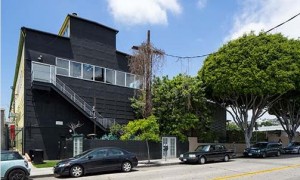
As evidenced by the recent loss of San Diego’s Michel-Carey house, sites important to LGBTQ history are vanishing. The Palms, Circus Disco and now The Factory in West Hollywood are all threatened with new development projects. Last Friday U.S. Secretary of the Interior Sally Jewell announced that the Henry Gerber House in Chicago, Illinois, has been designated a National Historic Landmark, becoming the nation’s second LGBT related property to achieve such recognition and yesterday the Stonewall Inn was landmarked in New York City.
Today, the National Trust for Historic Preservation named The Factory in West Hollywood to its 2015 list of America’s 11 Most Endangered Historic Places. This annual list spotlights important examples of the nation’s architectural, cultural and natural heritage that are at risk of destruction or irreparable damage. More than 250 sites have been on the list over its 28-year history, and in that time, only a handful of listed sites have been lost.
The building now known as The Factory is a Truscon Steel Company-designed industrial building built in 1929 to accommodate the booming success of the Mitchell Camera Corporation. Mitchell Cameras revolutionized filmmaking and fueled the growth of the film industry in Hollywood and around the world. By minimizing noise and maximizing functionality, these cameras enabled films to go from silent to “talkies,” and continued to influence camera technology until the digital era arrived in the early 2000s. Today, The Factory is one of the last remaining industrial buildings in West Hollywood built specifically for the technical aspects of the film industry.
Following the camera company’s move to the suburbs in 1946, The Factory was converted to serve a series of new uses, including a cosmetics warehouse, a furniture showroom, a private, celebrity nightclub, an antique market and an experimental theatre. It is most famously known as the home of Studio One, a pioneering gay disco that opened in 1974. Hosting the likes of Patti LaBelle, Joan Rivers and Liza Minnelli, Studio One and its Backlot Theatre were open seven days a week, had cutting edge sound and light systems, and a dance floor that regularly drew more than 1,000 people a night. Founded by a Beverly Hills optometrist and openly gay man, Studio One became a place for gay men to socialize and proudly and openly celebrate their identity. As such, it was associated with the gay rights movement throughout its history. When the AIDS epidemic hit in the early 1980s, for example, one of the nation’s first major fundraisers for AIDS research took place at Studio One.
Now The Factory’s legacy is threatened with demolition by a large-scale hotel project—one of the many new developments now jeopardizing West Hollywood and Hollywood’s LGBTQ heritage and early film industry history. The Robertson Lane Hotel project calls for a pedestrian “paseo” or walkway to run directly through a portion of the site on which The Factory now sits, a route that could easily be realigned to spare this landmark from the wrecking ball.
Richard Adkins, head of the nonprofit group, Hollywood Heritage put it best when he said, “It’s hard to see how far you have come when you have no evidence of where you began.”











